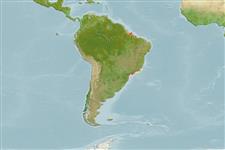Environment: milieu / climate zone / depth range / distribution range
Ekologi
laut; payau; kisaran kedalaman 1 - 22 m (Ref. 189). Tropical; 1°N - 27°S, 51°W - 32°W (Ref. 189)
Southwest Atlantic: mouth of Para River southward to Cananéia, Brazil.
Size / Weight / umur
Maturity: Lm ? range ? - ? cm
Max length : 6.8 cm SL jantan/; (Ref. 189)
deskripsi pendek
Morfologi | Morfometrik
Duri punggung (Keseluruhan (total)): 0; Duri dubur 0; Sirip dubur lunak: 22 - 25. Snout short, about 1/2 eye diameter; maxilla shorter than in most other Anchoa species, tip pointed, not reaching beyond hind margin of pre-operculum; gill cover canals of walkeri-type. Pectoral fins large, reaching about pelvic fin origin; anal fin fairly long, its origin below or just before midpoint of dorsal fin base. A silver stripe along flank, less than eye diameter.
Presumably schooling along beaches and down to 22 m. A single specimen was recorded from Coqueiros at the mouth of the Paraguaçu River, thus able to tolerate lowered salinities. More data needed.
Spawn in school (Ref. 205).
Whitehead, P.J.P., G.J. Nelson and T. Wongratana, 1988. FAO Species Catalogue. Vol. 7. Clupeoid fishes of the world (Suborder Clupeoidei). An annotated and illustrated catalogue of the herrings, sardines, pilchards, sprats, shads, anchovies and wolf-herrings. FAO Fish. Synop. 125(7/2):305-579. Rome: FAO. (Ref. 189)
Status IUCN Red List (Ref. 130435)
ancaman kepada manusia
Harmless
penggunaan manusia
Perikanan: tidak ada kepentingan
informasi lanjut
Umur / SaizPertumbuhanpanjang-beratpanjang-panjangukuran frekuensiMorfometrikMorfologiLarvaDinamika larvapemulihanKelimpahanBRUVS
AcuanBudidaya airprofil budidaya airStrainGenetikaElectrophoresesDiturunkanPenyakit-penyakitPengolahanNutrientsMass conversion
mitraGambarStamps, Coins Misc.Suara-suaraCiguateraKecepatanTipe renangArea insangOtolithsOtakPenglihatan / visi
Alat, peralatan
laporan khas
muat turun XML
Sumber internet
Estimates based on models
Preferred temperature (Ref.
123201): 22.5 - 28.2, mean 27.3 °C (based on 81 cells).
Phylogenetic diversity index (Ref.
82804): PD
50 = 0.5000 [Uniqueness, from 0.5 = low to 2.0 = high].
Bayesian length-weight: a=0.00513 (0.00232 - 0.01135), b=3.14 (2.96 - 3.32), in cm total length, based on LWR estimates for this Genus-body shape (Ref.
93245).
Trophic level (Ref.
69278): 3.3 ±0.4 se; based on size and trophs of closest relatives
Daya lenting (Ref.
120179): Tinggi, Waktu penggandaan populasi minimum kurang dari 15 bulan (Preliminary K or Fecundity.).
Fishing Vulnerability (Ref.
59153): Low vulnerability (10 of 100).
Nutrients (Ref.
124155): Calcium = 544 [282, 1,400] mg/100g; Iron = 2.63 [1.41, 4.91] mg/100g; Protein = 17.1 [14.8, 19.8] %; Omega3 = 0.327 [0.152, 0.686] g/100g; Selenium = 33.6 [14.2, 83.5] μg/100g; VitaminA = 34.9 [10.4, 96.6] μg/100g; Zinc = 2.93 [1.91, 4.41] mg/100g (wet weight);
